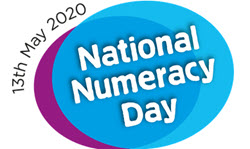Numeracy, probability & coronavirus
Wednesday 13 May 2020
 Today is National Numeracy Day in the UK. I discovered this by coming across the following article in The Guardian newspaper this morning written by the chief economist of the Bank of England, Andy Haldane: Numeracy skills are vital as we emerge from the coronavirus crisis. The article includes worrying facts about the negative impacts the the virus pandemic is having on people's finances; and also worrying facts about numeracy - such as "about half of the UK adult population have numeracy skills that are no better than those of a primary school child." The article makes some useful points about the correlation of maths skills with financial literacy. However, my favorite message in the article was the notion "...that there is no such thing as having a maths brain." Haldane was making this point in reference to the resuls from 300,000 people taking the National Numeracy Challenge (try it - takes about 10 minutes).
Today is National Numeracy Day in the UK. I discovered this by coming across the following article in The Guardian newspaper this morning written by the chief economist of the Bank of England, Andy Haldane: Numeracy skills are vital as we emerge from the coronavirus crisis. The article includes worrying facts about the negative impacts the the virus pandemic is having on people's finances; and also worrying facts about numeracy - such as "about half of the UK adult population have numeracy skills that are no better than those of a primary school child." The article makes some useful points about the correlation of maths skills with financial literacy. However, my favorite message in the article was the notion "...that there is no such thing as having a maths brain." Haldane was making this point in reference to the resuls from 300,000 people taking the National Numeracy Challenge (try it - takes about 10 minutes).
What does this have to do with probability and the coronavirus pandemic (alluded to in the title to this blog entry)? Good question. Well, many of the news that we get about the pandemic has lots of numerical information - statistics, percentages, infection rates, transmission rates (the R value that politicians like to talk about), etc. I came across another newspaper article this morning (can you tell how I'm spending some of my time in lockdown?) that had the following sub-title: In a population whose infection rate is 5 percent, a test that is 90 percent accurate will deliver a false positive nearly 70 percent of the time. The article is about the accuracy of antibody tests that are meant to determine whether an individual has developed some immunity to the new coronavirus. Some of my favorite exam-like questions in probability involve finding the probability of a false positive (or false negative). Often the answer is surprising and counter-intuitive - and displays the power of mathematics to shine a light on what is really occuring. So, I was immediately intrigued by this article in the NY Times today: Just Because You Test Positive for Antibodies Doesn’t Mean You Have Them. And, I learned about something in the study of decision-making referred to as the base rate fallacy. Actually I and my students had experienced this with some of those challenging probability questions that display a higher than expected probability for a false positive result (see my Math HL problem-of-the-day #106). The authors of the article point out that one of the most common decision-making errors involves the base rate fallacy and a misunderstanding of probabilies; and they referenced an interesting article written more than 40 years ago: The Base-Rate Fallacy in Probability Judgements (possible Exploration topic about the base rate fallacy?). Although probability problems involving conditional probabilities and false positives are a few notches above basic numeracy skills, there is no doubt that developing a strong fluency and understanding of probability concepts and methods should be a goal of secondary maths courses such as this one. It certainly shines a light on the fact that antibody tests are not going to be as helpful dealing with the coronavirus pandemic as many politicians are claiming.

